We’ve put together everything you need to know about doing your first Liveaboard diving trip in this article that is jam-packed with insider tips and advice. We aim to answer all your questions and get you prepared for planning your ultimate Liveaboard diving experience.
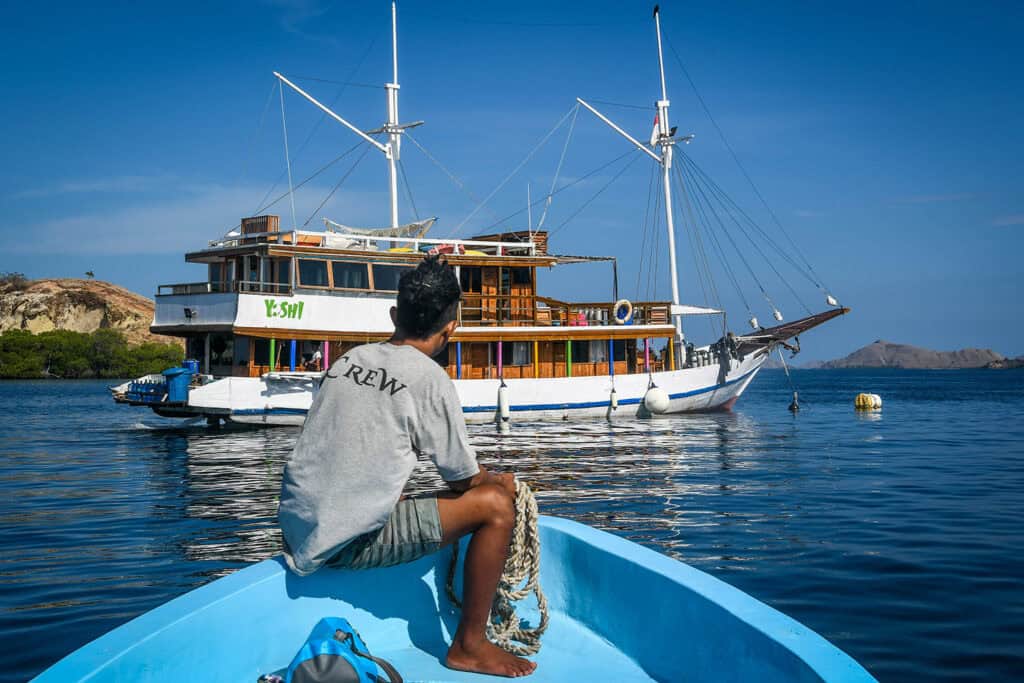
Picture this…
Waking up to the sun rising from the depths of the great blue sea stretching out in all directions. You sip on a coffee as the sky changes colors and the breeze plays with your hair. You slip on your wetsuit, gear up, and jump into clear waters and are quickly surrounded by fish and corals of all colors.
When you make it back onto the boat for breakfast at 9 a.m., you’ve already completed a dive, but the fun is far from over. By sunset, you’ll have 4 dives under your belt, and tomorrow you’ll do it again.
If this sounds dreamy to you, we’ve got the perfect idea for your next vacation…a Liveaboard diving trip!
Participating in a Liveaboard diving trip is the best way to get the most out of your diving experience in any location. You’ll spend your days cruising from one dive site to another, diving up to 4 times a day.
Not only will you get a lot of dives logged on a Liveaboard, but oftentimes the sites you’ll visit are ones you can’t see on day trips. This means you get to see reefs and marine life that hasn’t been affected by tourism and crowding at the dive sites as you would closer to shore.
And on top of that, you get to meet new friends from around the world, relax in the sun and sleep beneath the stars.
In this article, we’re answering all your questions about Liveaboards (trust me, we were wondering all the same things!) so that you have all the tools and knowledge to start planning your very own epic Liveaboard diving trip!
Liveaboard Diving Guide
- What is a Liveaboard?
- Our experience with Liveaboard diving
- Typical daily schedule
- Liveaboard boats
- Food on a Liveaboard diving trip
- How does Liveaboard diving work?
- Why choose Liveaboard?
- How much does a Liveaboard diving trip cost?
- How to book a Liveaboard diving trip
- Questions to ask before booking
- Liveaboard packing list
- Eco-friendly Liveaboard tips
What is a Liveaboard?
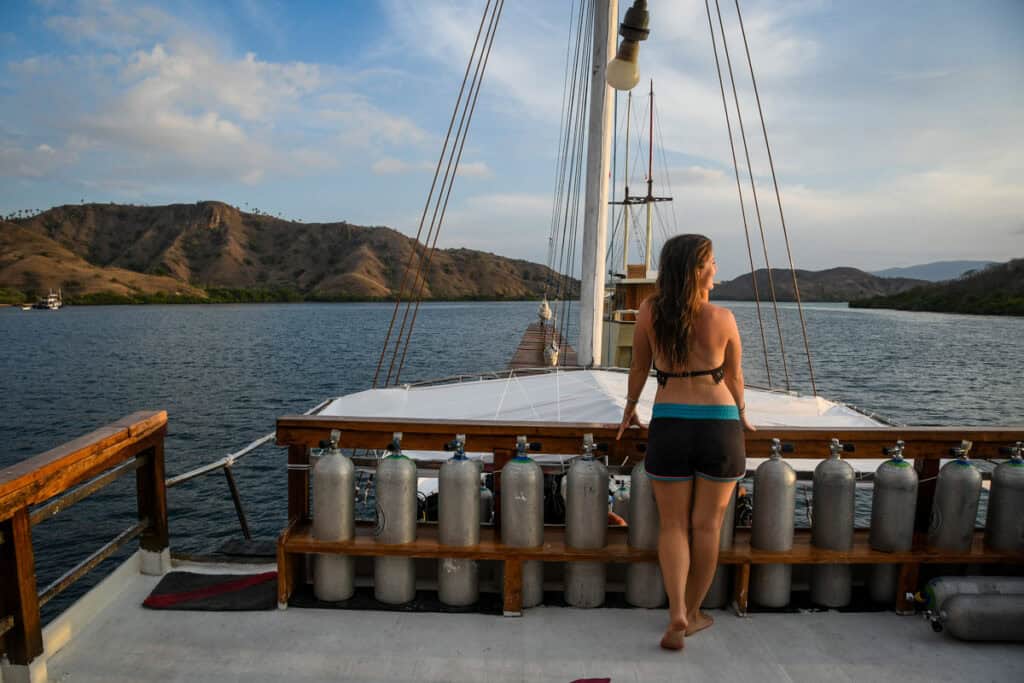
You may be asking yourself… What exactly is a Liveaboard??
In the simplest definition, a Liveaboard is a multi-day boat trip that is often times focused on scuba diving*.
Most Liveaboard diving trips take a small group of guests (around 16, depending on the boat) and have fully catered facilities. Guests get the option to choose their own room or stay in a shared bunk room, and actually sleep, eat and relax on board the ship when they are not diving.
Trips are anywhere from 3 days to full 14-day excursions in some of the world’s top diving destinations where you will eat, sleep, and dive, day after day.
*There are non-diving Liveaboards too, but for the purpose of this article, we’ll be focusing on only diving Liveaboards.
Our experience with Liveaboard diving
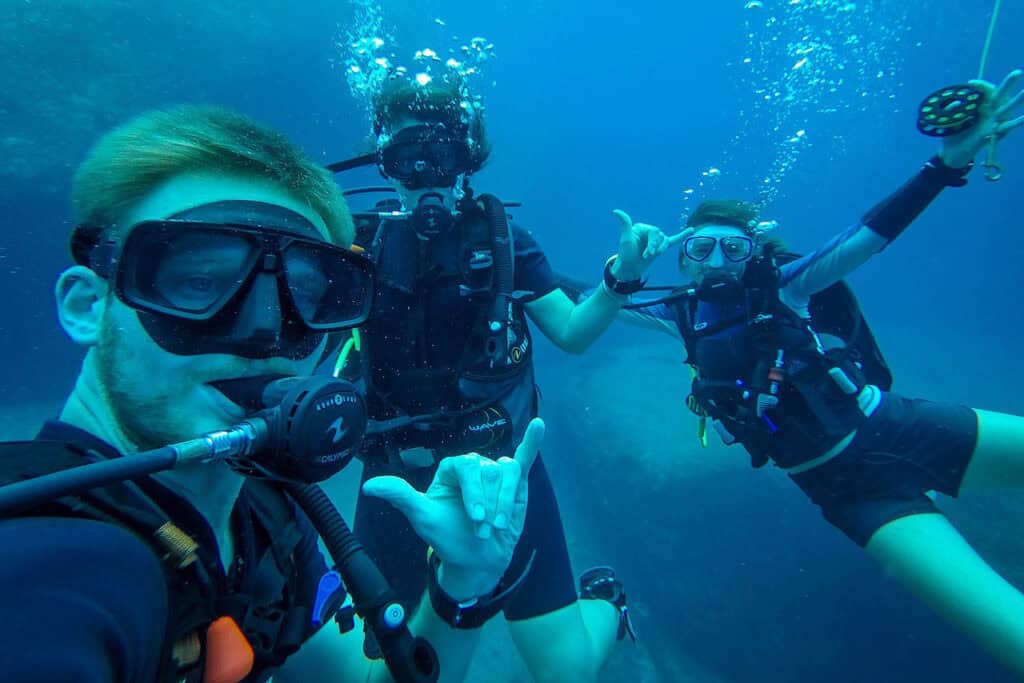
While traveling in Thailand a few years ago, we met a girl who had just finished a Liveaboard diving trip and scrolled pictures of her diving next to a whale shark. Our interest was piqued…
This was our first time ever hearing about Liveaboard, so we bombarded her with all sorts of questions and nodded dreamily at her answers.
- Do you sleep on the boat? Yes, there are dorms and even private rooms.
- How many dives do you do each day? It depends, but usually 3 a day, and possibly up to 4!
- Are Liveaboards expensive? Prices vary, but they don’t have to be! There are budget liveaboards all the way to luxury dive trips, and of course, everything in the middle!
- What else do you do on a Liveaboard? Relax in the sun, read a book, swim, eat, make new friends from around the world, play cards, nap, eat some more, soak up time “off the grid”, talk about diving… Well, this all sounds dreamy.
Let’s just say that after this conversation, we were hooked.
We started doing all sorts of research, and found that there are liveaboards all over the world — from the Caribbean to the Galapagos Islands to Australia, and of course, Southeast Asia.
And then we did what we do best: we started plotting and planning and were determined to make our dreams of doing a liveaboard trip come true.
We didn’t even have our diving certifications at the time, so getting Open Water certified was the first thing on our to-do list. Turns out we liked scuba diving so much, we stuck around and got our advanced certs as well!
And just like that, we were on our first Liveaboard in Similan Islands, Thailand. We had such a wonderful experience that our fins… err, feet… were itching to do another.
So we booked a second voyage, this time in Indonesia on a Komodo Liveaboard. And let me tell you, this certainly won’t be our last Liveaboard!
Don’t just take our word for it… See for yourself with this video from our most recent Komodo Liveaboard experience.
Typical daily schedule on a Liveaboard diving trip
While each day on a Liveaboard diving trip will vary slightly, and your schedule will be dependent on the location as well, here’s the gist:
Dive, Eat, Sleep, Repeat.
But don’t worry, if you’re not feeling well, are tired, or just need a break from diving, there’s nobody forcing you to go. You can always sit out a dive if you want. (In our experience, we have found the excitement returns dive after dive and we never wanted to miss any of the action!)
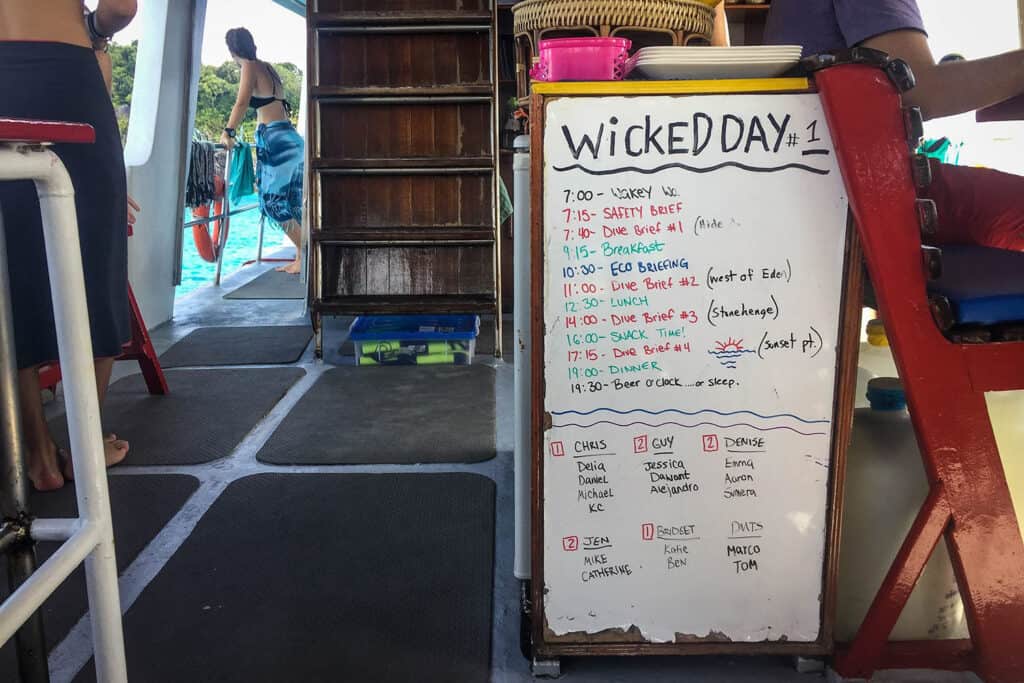
Here’s an example of what a typical schedule might look like on a Liveaboard diving trip:
- 6 a.m. Wake up around sunrise
- 6:15 a.m. Coffee and light bites
- 7:30 a.m. 1st dive of the day
- 9 a.m. Breakfast
- 9:30 a.m. Hang out on the sun deck
- 11 a.m. 2nd dive of the day
- 12:30 p.m. Lunch
- 1 p.m. Nap and hang out on the sun deck
- 2:30 p.m. 3rd dive of the day
- 4 p.m. Afternoon snacks
- 4:30 p.m. Relax and read
- 6:30 p.m. Dinner and chat
- 9:30 p.m. Early to bed so you’re ready to do it all over again
Note: The dive times vary each day. For example, on our Komodo Liveaboard, we did two night dives, so the other dives on those days weren’t as early in the morning.
Liveaboard diving boats
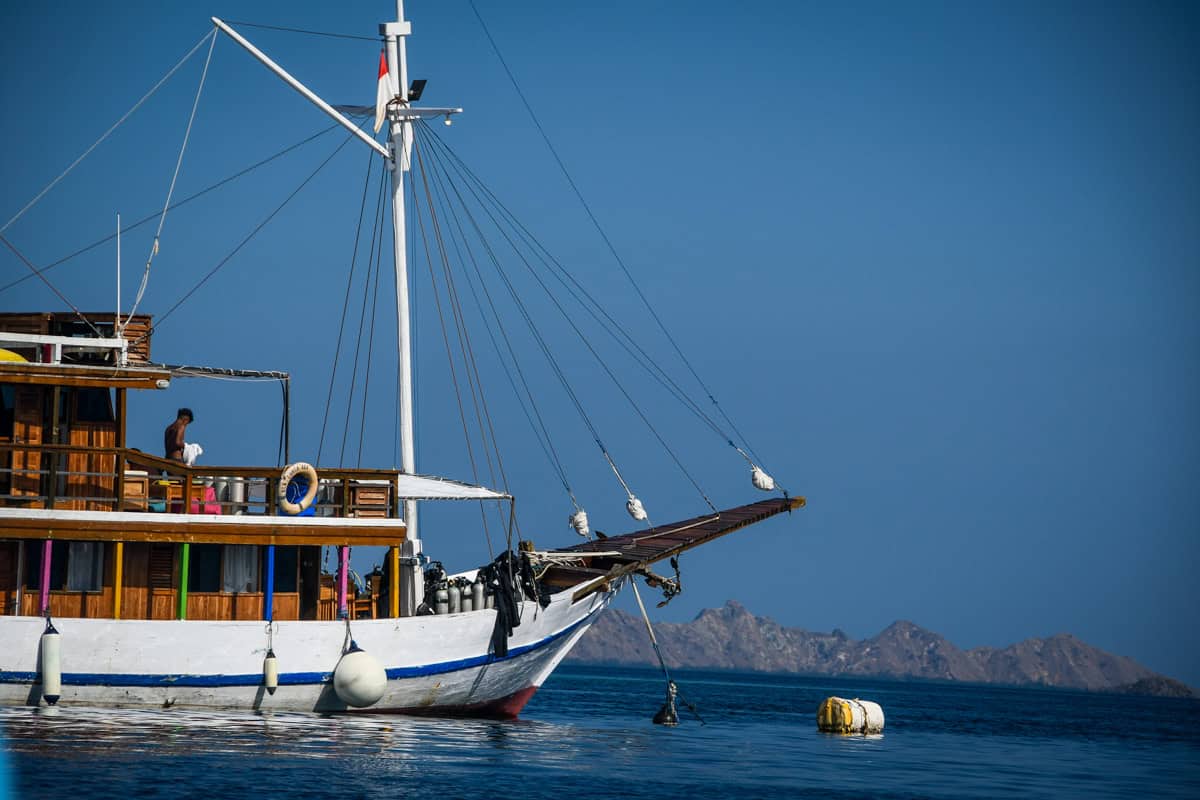
So what exactly is the boat like that you’ll be living on for multiple days on end? Where do you sleep? And perhaps even more importantly, how are the bathrooms?
These are all great questions, but truthfully, it depends on the boat you choose. Each Liveaboard is different, and the higher the price tag, the more plush you can expect the boat to be.
But even the more affordable boats are still quite comfortable. Let’s take you on a tour!
Bedrooms on a Liveaboard
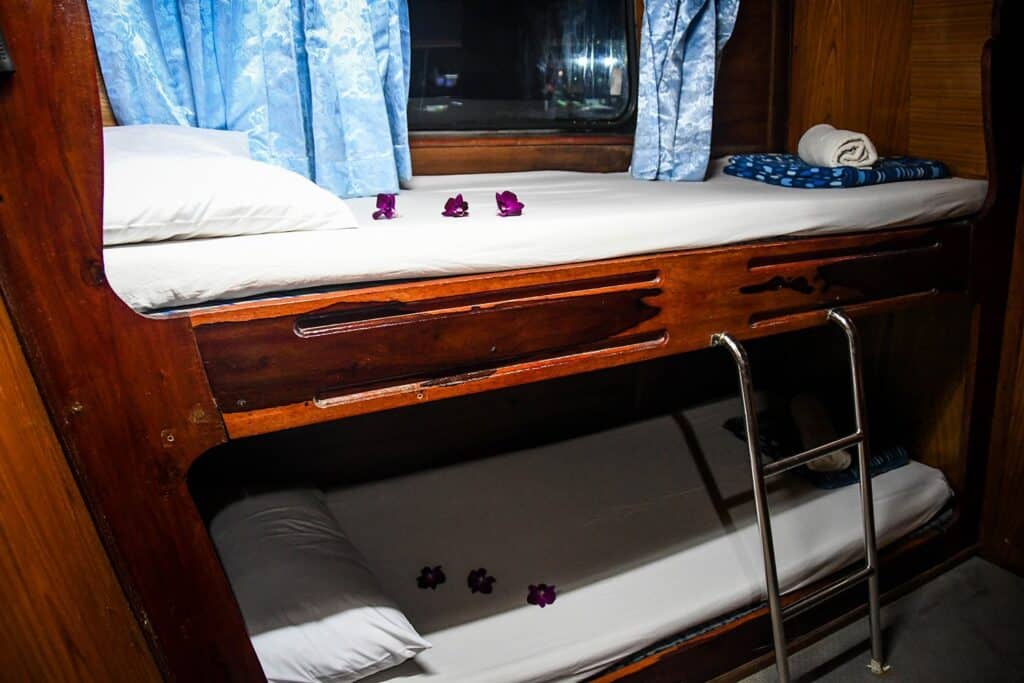
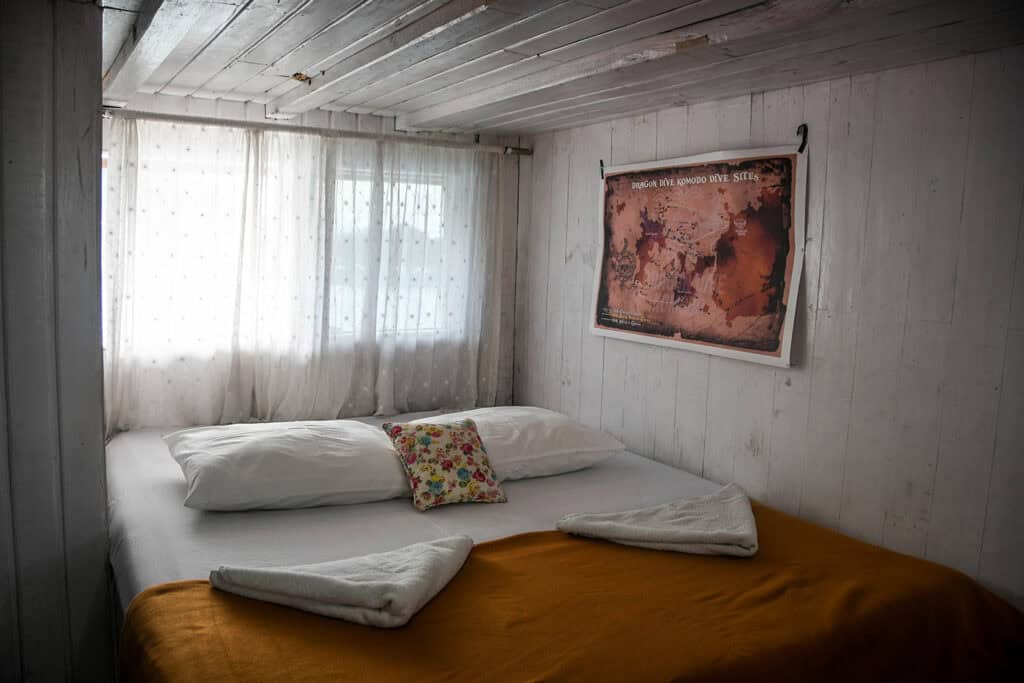
You can often choose between a bunk in a dorm room (perfect choice for a solo traveler or a couple on a tight budget!), or a private room of your own. Both of the Liveaboards we’ve been on had air-conditioning and surprisingly comfortable beds.
During our Komodo Liveaboard, the generator was shut off at night, so sleeping on the top deck on a beanbag or hammock turned out to be much more comfortable. You get a nice breeze and a view of the night sky with no light pollution.
Bathrooms on a Liveaboard
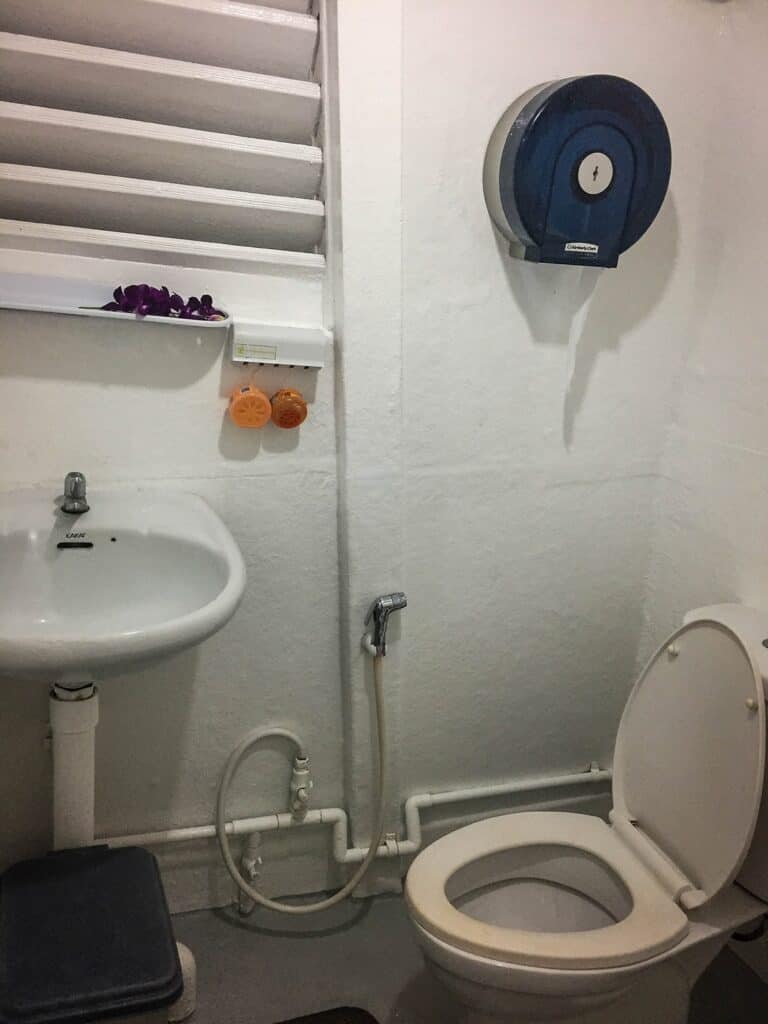
For some reason, I was more curious about the bathrooms on a Liveaboard boat than I was about the actual room itself. If you’re like me and you’ve been wondering the same thing, don’t worry — we’ll tell all!
Again, it totally depends on the boat you choose, but both of our experiences on Liveaboards had very comfortable bathrooms.
On our Thailand trip, there were 3 shared bathrooms on board, and aside from once or twice, we rarely had to wait to use them.
On our Komodo National Park trip, we had a private bathroom inside our deluxe room with a flush toilet and—get this—a shower with WARM water (not hot, but I’ll take what I can get in the open ocean!).
You can expect Western-style toilets on all Liveaboard boats that are kept clean. One thing to note is that you cannot dispose of paper or sanitary products in the toilets. It is even more important on the boat than it is on land, as these are marine toilets and eventually everything that is flushed will end up in the water.
There is a bin to dispose of anything you cannot flush. If you have been traveling in Asia or Central America at all, you’ll likely be very used to this habit. Each bathroom also has a shower, and surprisingly, the hot water works pretty well and the pressure is strong.
PH neutral shampoo, conditioner and body wash are usually provided on Liveaboards. You are asked to refrain from using your own products onboard so you don’t compromise the marine life.
Common spaces on a Liveaboard
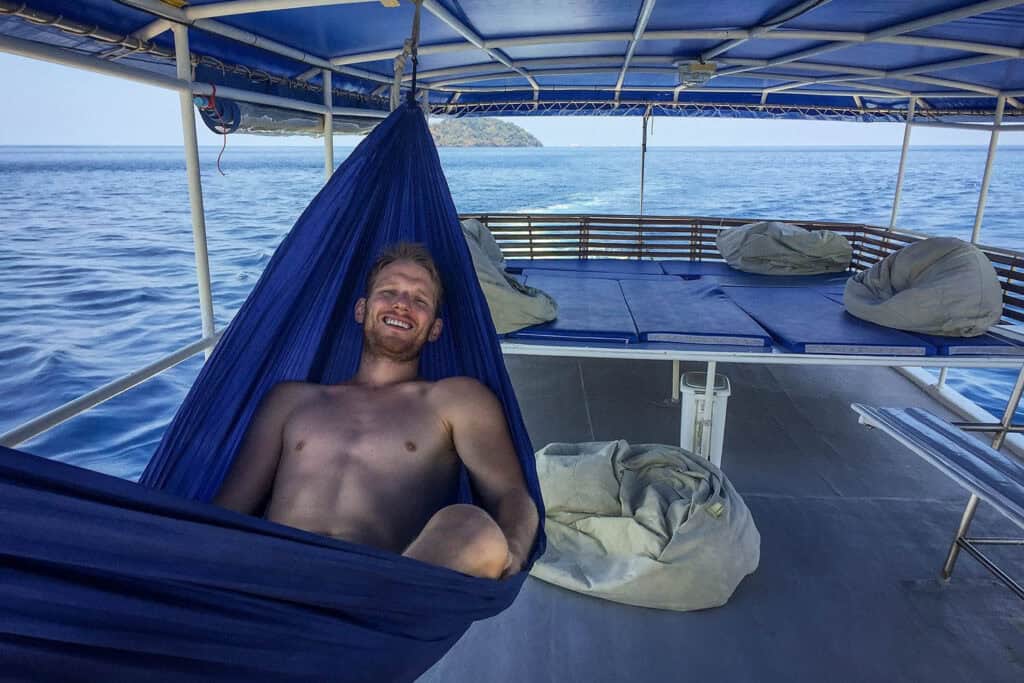
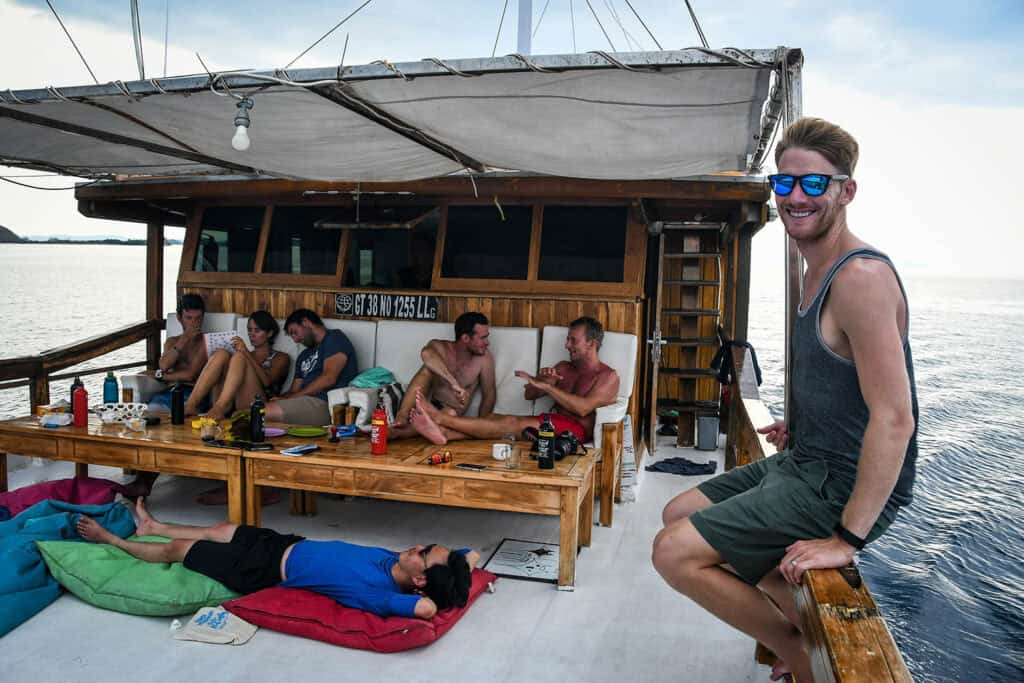
Every Liveaboard boat, whether luxury or budget, will have a couple of common areas to hang out and relax in. You can expect a sundeck as well as a shaded area (sunburns are no fun on a dive trip!).
Grab a hammock or bean bag and unwind with a good book or chat with other guests about your last dive.
Food on a Liveaboard
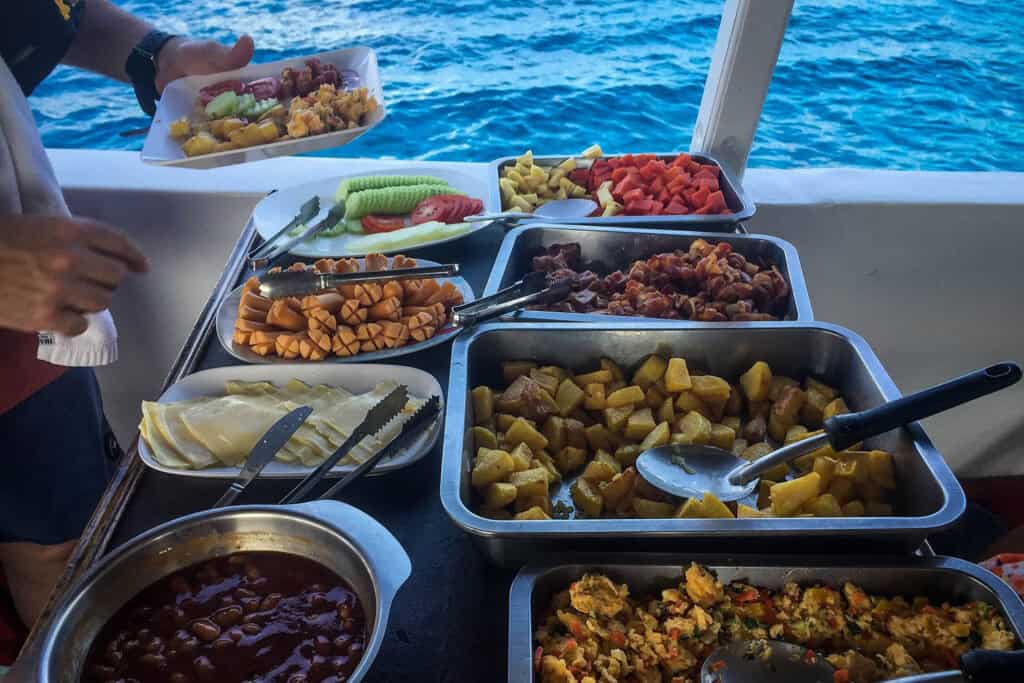
Let’s just say that we have been really surprised (in a good way!) with the quality of food on each of our Liveaboard diving trips.Considering that the chef needs to cook food for a large group while on a boat with limited space, we were pretty darn pleased with the meals that were served.
On both our Similan Islands and Komodo Liveaboard trips, we ate lots of local dishes, like curries, seafood, grilled meat, noodles, rice and fruit.In addition to breakfast, lunch and dinner, there was also an afternoon snack of smoothies and fried bananas to enjoy between dives.
Let’s just say, there is plenty to eat on a Liveaboard diving trip!
Note: If you have any dietary restrictions or allergies, let them know before your trip and they can accommodate you.
Liveaboard staff and crew
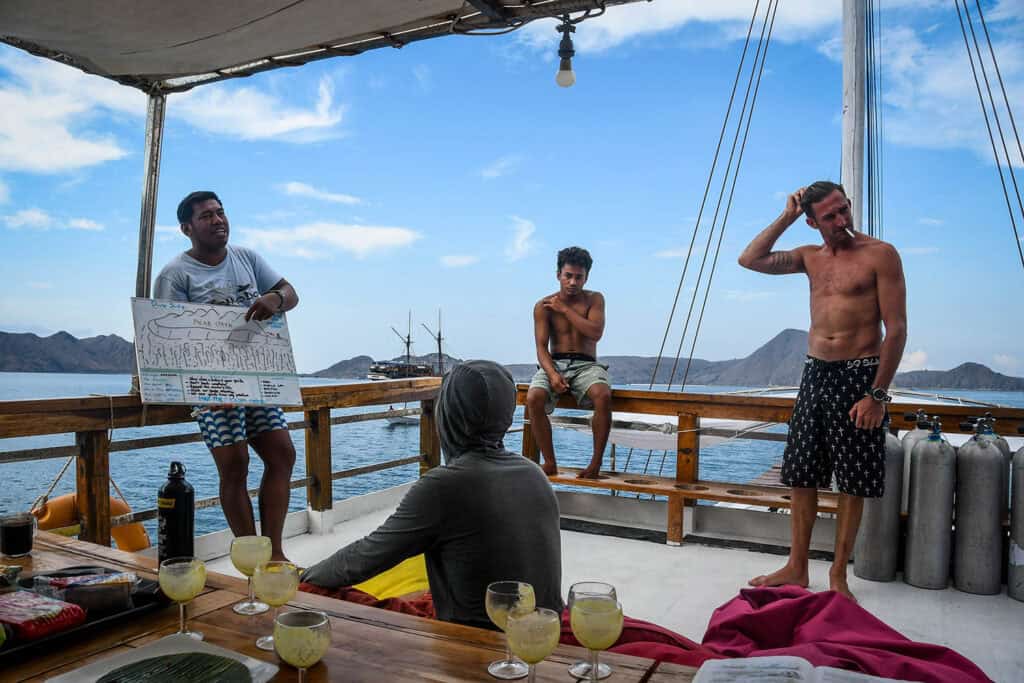
There is a crew onboard each Liveaboard boat who take care of the boat, cook meals and help with getting the equipment ready to dive each day; and the captain (or course!).
The ratio of instructors to guests varies by trip, but the group sizes onboard are small. There are generally no more than 4 divers to each instructor. On our Thailand voyage, we had a guide all to ourselves which was really fun!
Other divers onboard
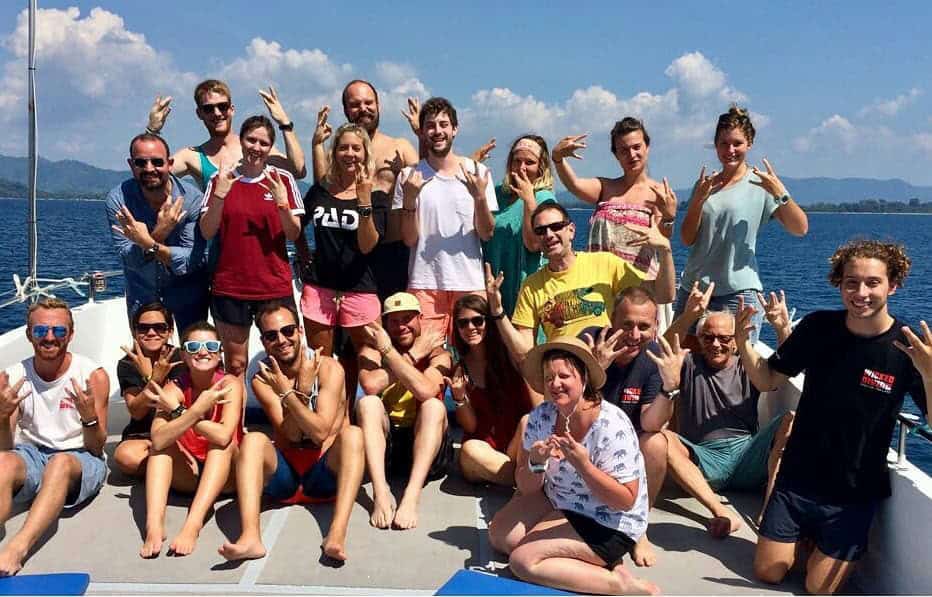
There are people from all walks of life on Liveaboard trips. Two-week vacationers, backpackers, couples, solo travelers, students, professionals. And all ages too!
And much the same, everyone comes with their own level of diving experience.
One guest on our Thailand Liveaboard had gone diving for his first time just a week before to get his Open Water certification. Others had been avid divers for years and have experience diving all over the world.
If you are a solo traveler, doing a Liveaboard diving trip is a great way to meet other travelers as there are usually a handful of solo travelers onboard. And all Liveaboards have options for singles (usually in a shared room or dormitory).
How does Liveaboard diving work?
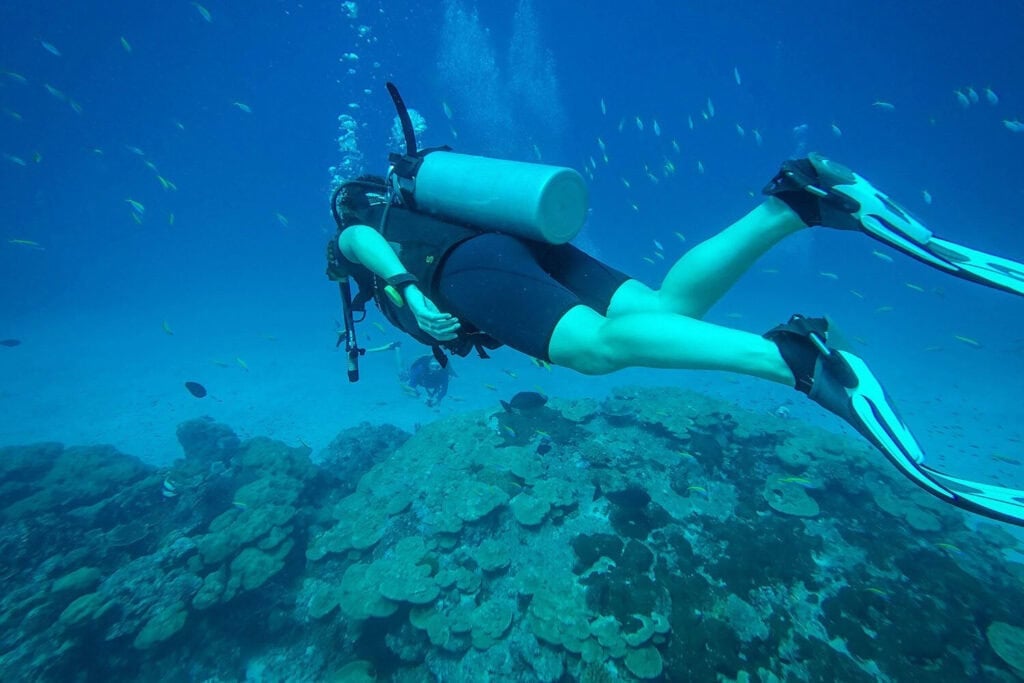
Diving on a Liveaboard is a lot like booking a dive at a dive shop on land, except it’s like you never leave the dive shop and you’re eating and sleeping alongside your guides.
With scuba diving at the center of your time spent on a Liveaboard, everything is set up to make your diving excursions as seamless as possible.
Generally, you’ll receive a schedule each night which includes the times of your briefings as well as the dives for the following day. A crew member will go around and wake everyone up in the morning before the first dive of the day.
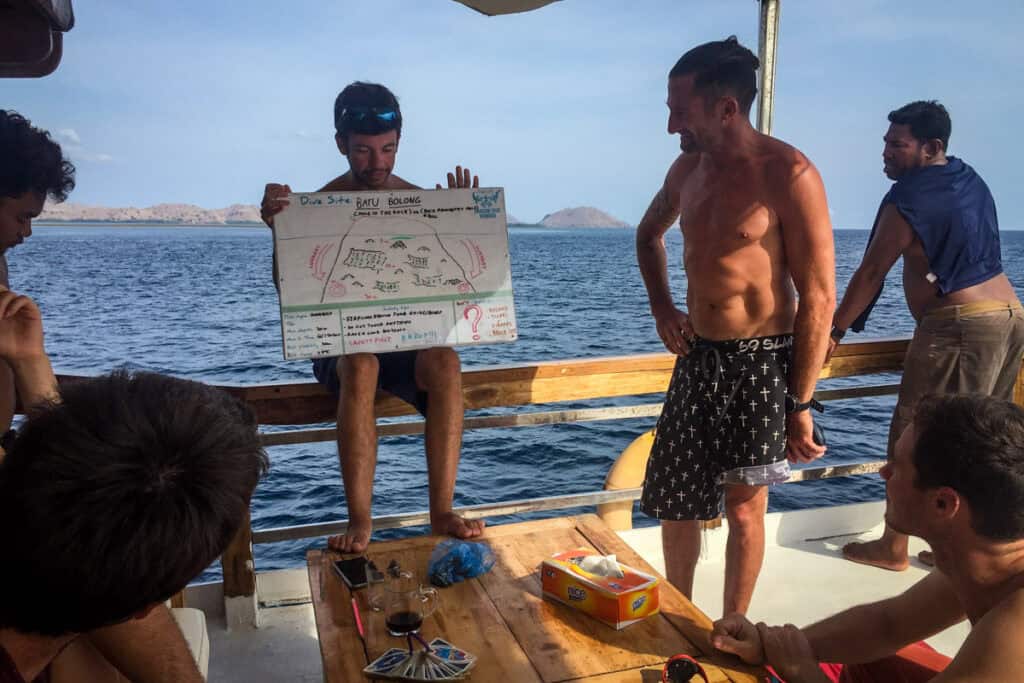
Before each dive you’ll have a briefing with your guides, just as you would on land, to go over what you need to know about the site and any special procedures or marine life you’re likely to encounter.
After your briefing you’ll gear up before entering the water. Depending on the Liveaboard boat, you’ll either gear up on the dive deck onboard, or transfer to a separate tender (just a smaller boat) to gear up and reach the dive site.
Diving experience requirements
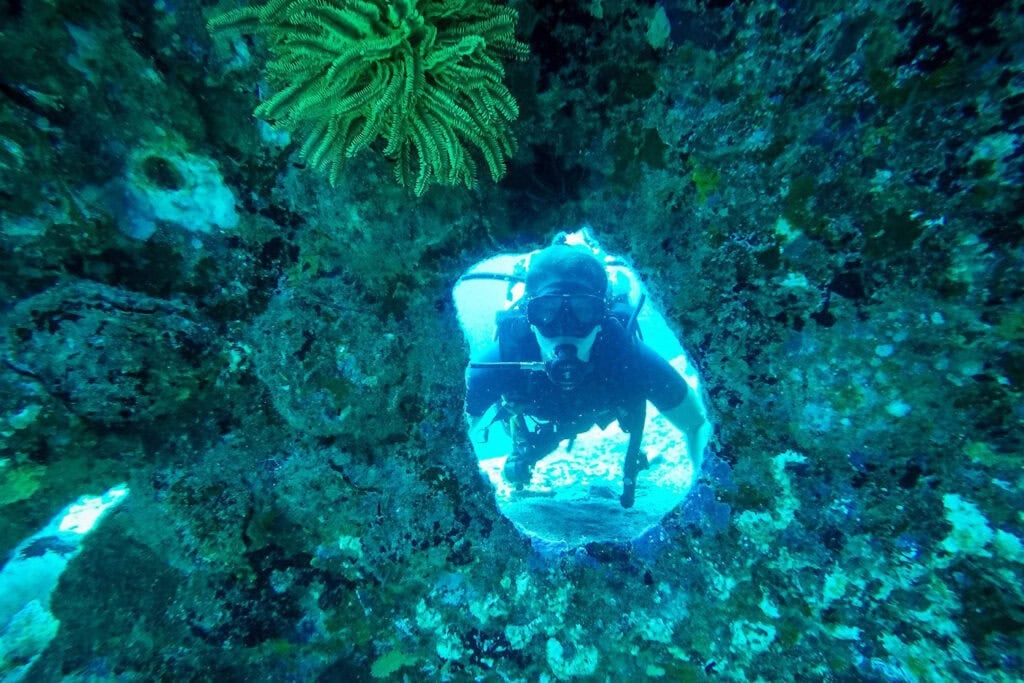
You may be wondering what kind of prior diving experience you need to do a Liveaboard diving trip. We were too before we booked our first one!
Many Liveaboards will welcome those with Open Water certifications and above (be sure to check with your boat ahead of time).
In our shared opinion, having your advanced open water certification allows you to fully explore the dive sites a bit more. For example, at some of the sites, the advanced divers can dive to 30 meters, while those who don’t have their advanced certification can’t explore the dive site as extensively because they can only go to a maximum of 18 meters.
All this said, you can usually get your advanced certification ON the boat! How cool is that?! Three people aboard our Thailand voyage came in Open Water Divers and left with Advanced certs.
And what if you have your certification but haven’t been diving in a while?
To be honest, I was a bit nervous before our first Liveaboard. It had been 2 years since we’d been diving in Koh Tao, and everything was a bit fuzzy. We booked a refresher course for the morning before our dive trip, and we were very happy we did.
Safety while diving
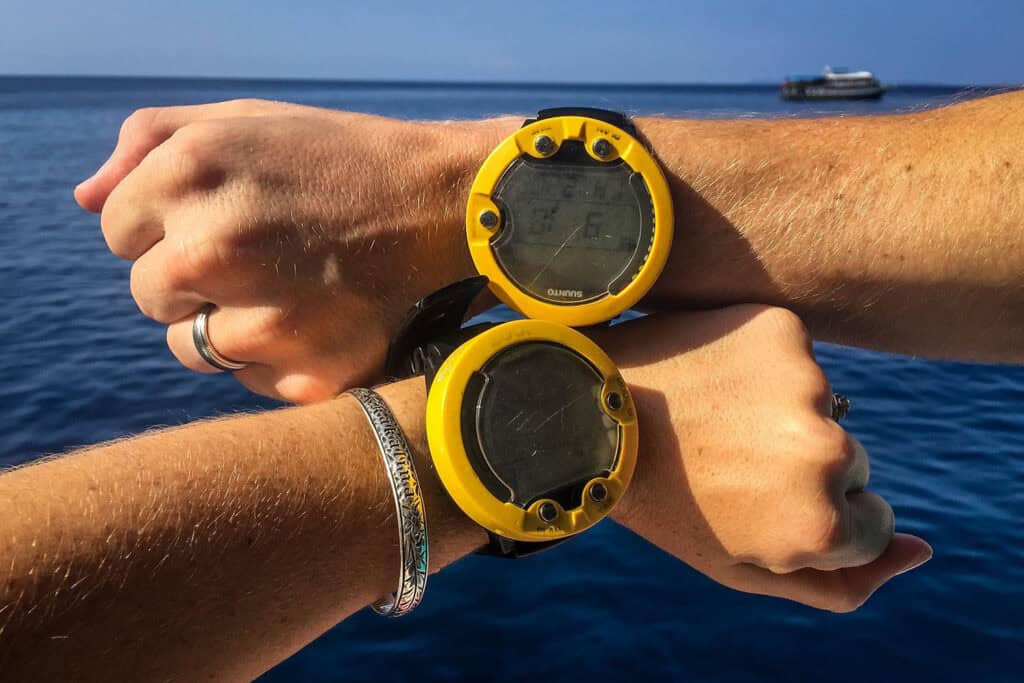
The diving practices will depend largely on your instructors, but for the most part, the staff on Liveaboard diving boats are super professional and have been trained to handle all types of situations.
Before each dive, the dive staff checks the currents and the conditions and communicates any things you may encounter on the dive briefing.
Be sure to ask about safety practices before booking your trip to make sure you will be in good hands.
What’s included in your Liveaboard diving trip?
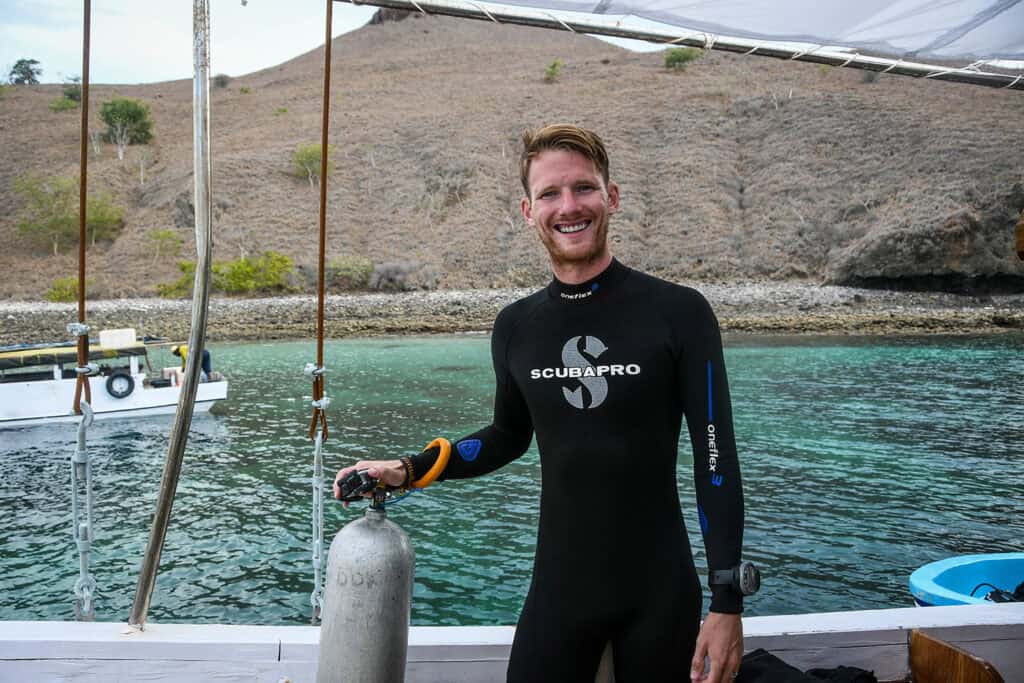
Liveaboard diving trips usually include 3 dives per day with an experienced dive guide, and sometimes also include various onland excursions depending on your route.
Specifics included in each Liveaboard will depend on the boat/trip you choose. However, there are some general inclusions that are covered on all Liveaboard diving trips.
As a guest on a Liveaboard, you will have accommodation onboard for all nights, as well as all meals included in the price. You will also have access to all the equipment needed for diving, though you are more than welcome to bring your own equipment if you have it.
Basic diving equipment is generally included in the price of your Liveaboard. However some boats charge an extra daily fee for rental gear, and exactly what’s included may vary from boat to boat. For example, we paid $10 USD each per day for our rental gear on our Komodo Liveaboard.
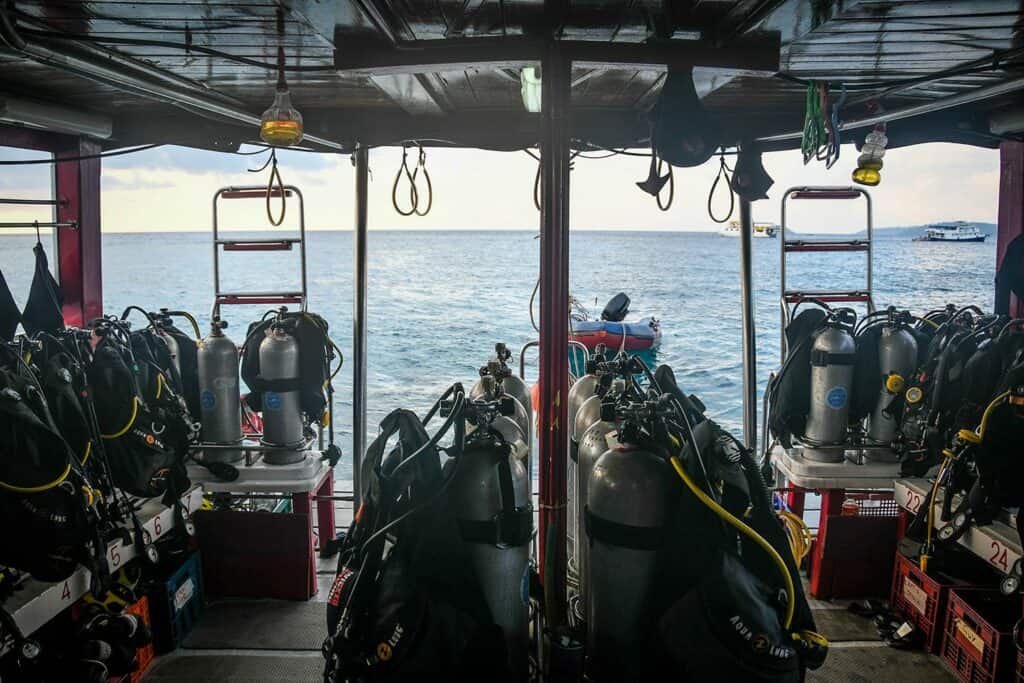
Included in your Liveaboard price is the necessary diving equipment:
- Air Tanks
- BCD & regulators
- Weight belt
The following may be included in your Liveaboard price, or may cost an additional rental fee depending on your trip. Ask ahead so you know what extra fees to expect!
- Dive computer
- Wetsuit
- Mask
- Fins and Booties
Insider Tip: We’d recommend purchasing your own mask, as this piece of equipment will be much more comfortable when it fits your face properly. If you purchase only one piece of scuba gear, this should be it. The rentals just can’t fit every face properly, so you may get some leaking. Depending on your personal preference and your face shape, you might even want to consider getting a full face diving mask.
Why choose Liveaboard for your next diving adventure
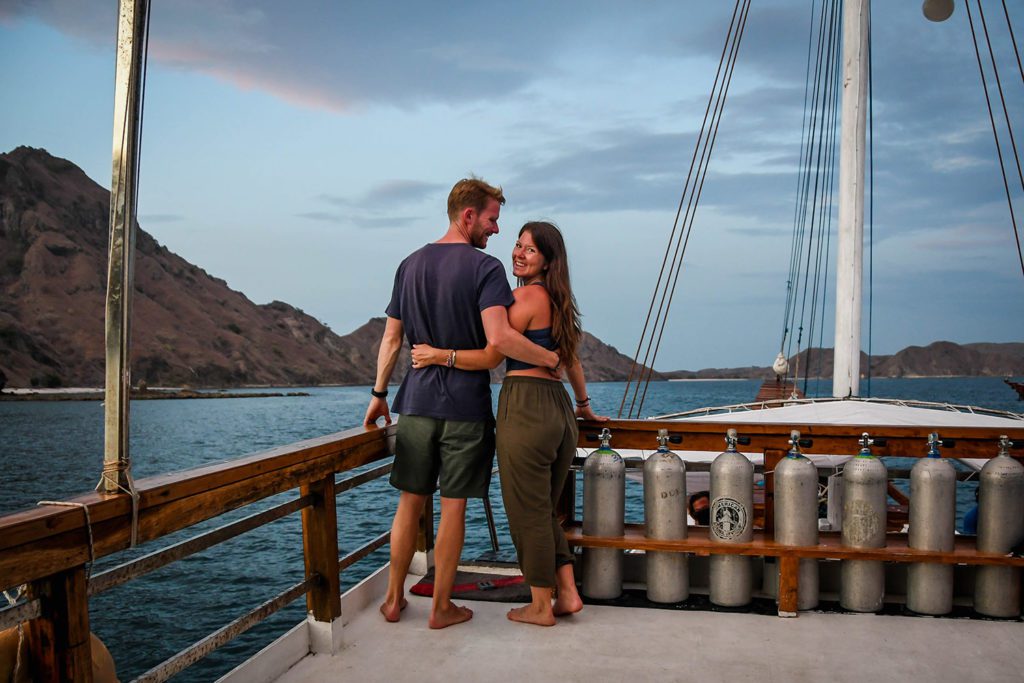
Choosing a Liveaboard for your next diving adventure offers several compelling advantages:
1. Maximize your diving time
Liveaboard diving trips allow you to dive multiple times a day, often up to four or five dives, including night dives. This means more underwater time and the opportunity to explore a variety of dive sites within a single trip.
2. Access to remote sites
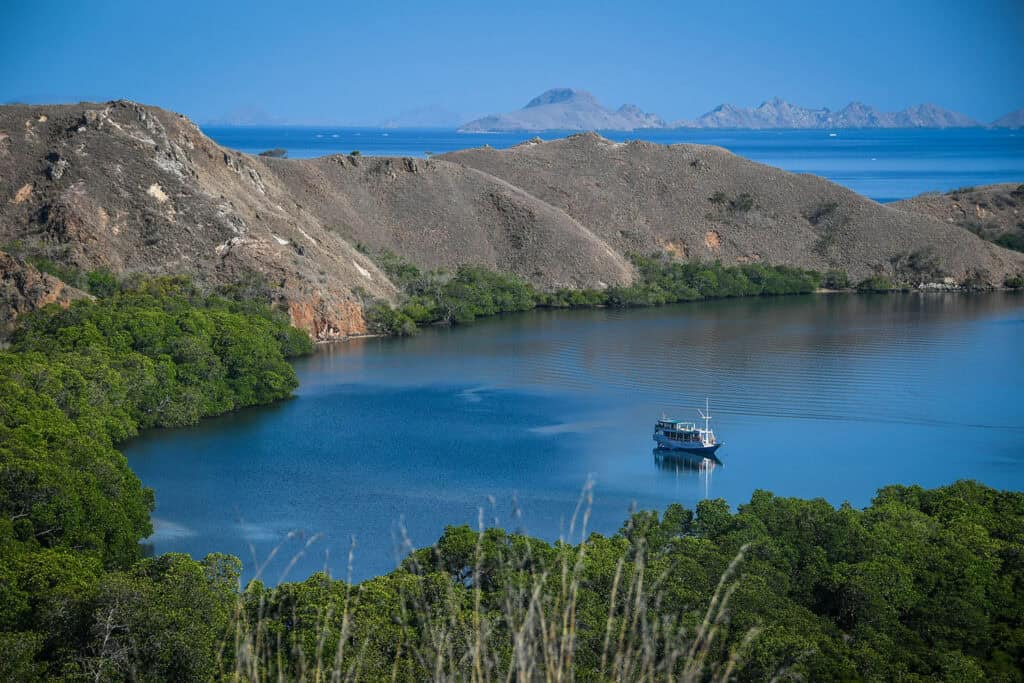
Liveaboards can reach remote and less accessible dive sites that day boats cannot. This means you’ll have the chance to dive in pristine locations with fewer crowds and untouched marine environments.
The ability to explore a wider range of dive sites increases your chances of encountering diverse marine life; from pelagic species like whale sharks and manta rays to vibrant coral reefs and macro critters.
3. Get more bang for your buck
Yes Liveaboard diving might seem expensive, but if you think about what it would cost you to do 3-4 guided dives per day, plus rental gear, plus pay for your food and accommodation, you’ll likely find it’s actually quite a cost-saver.
4. Log lots of experience
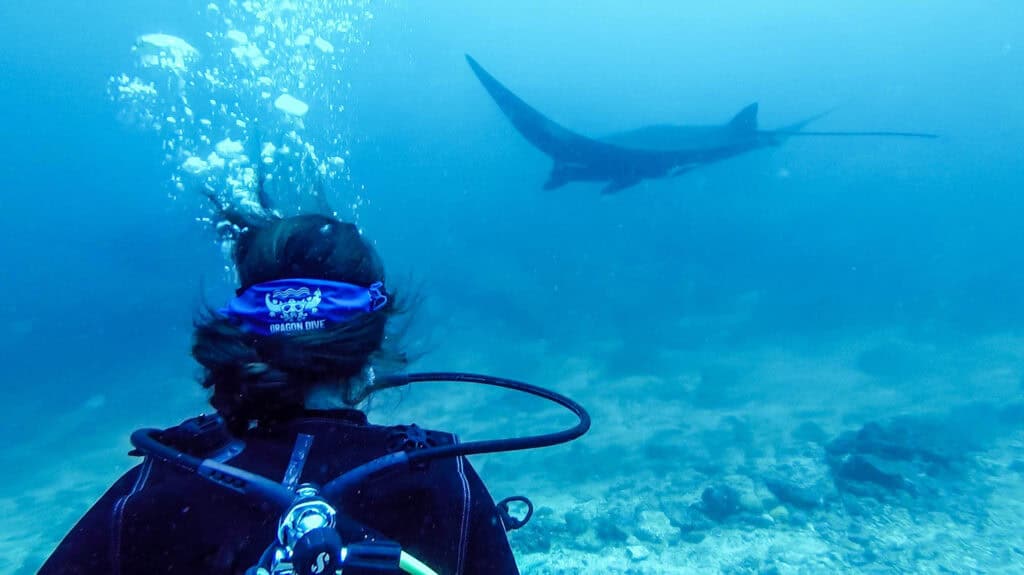
If you’re looking to up your scuba game and log lots of dives in a short amount of time, a Liveaboard is an excellent way to do just that.
Often with 3-4—sometimes even 5—dives per day, you could double or even triple your dive count in just one trip.
This is also a great way to get really comfortable underwater. The repetition and comfort of having qualified and experienced dive guides at your side in small group settings will allow you plenty of practice.
4. They are super convenient
With everything you need onboard, including gear storage, meals, and accommodations, a liveaboard offers a hassle-free diving experience. You wake up, dive, eat, relax, and sleep all in one place.
5. Build community and make new friends
Liveaboard trips often foster a sense of community among divers. You’ll be sharing your adventure with like-minded individuals, creating lasting friendships and sharing experiences both underwater and on deck.
How much does a Liveaboard diving trip cost?
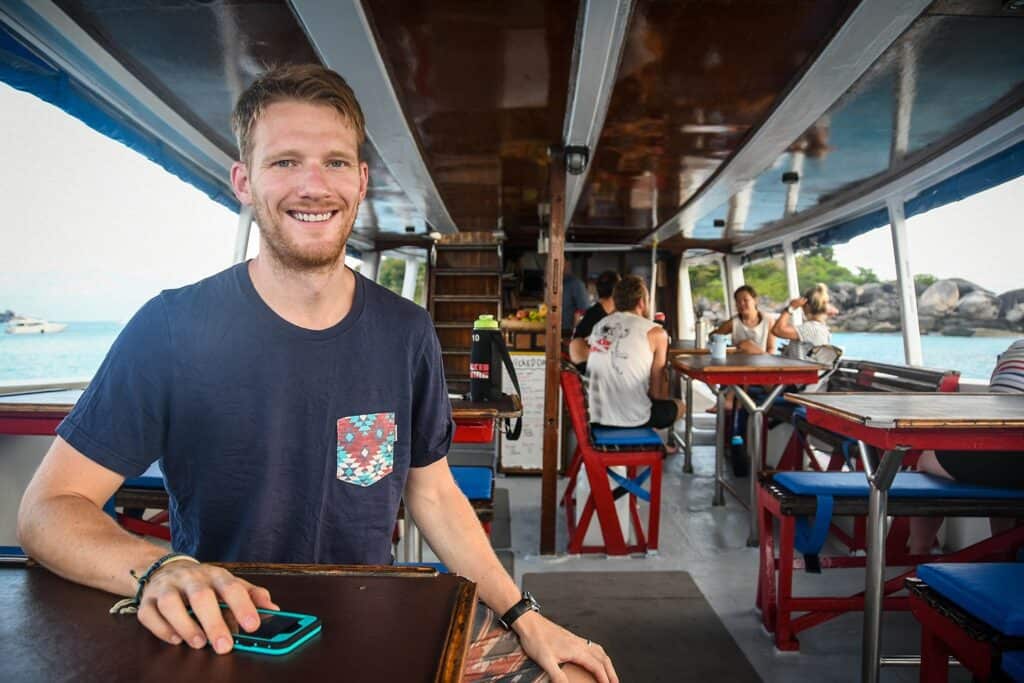
Now there’s the question we know you’re wondering! Let’s just say that the cost of a Liveaboard diving trip is going to vary drastically based on what type of company you choose. It also depends on where in the world you will be diving; for instance, Thailand is going to be much cheaper than Australia or the Galapagos.
If you go with the most affordable option out there, likely in Southeast Asia, you can expect to pay around $120 USD per day. This covers your accommodation, instructors, transportation and all your meals and your dives. So when you really break it down, it’s not that bad.
If you’re going the ultra-budget route, be prepared for dorm-style bunk rooms, and you might even want to be prepared to sleep on the deck beneath the stars (which we found out is actually quite nice!).
If your budget is bigger though, you might have a nicer room, a more luxurious boat and more upscale meals. You can easily pay upwards of $500+ per day on some of the really luxurious Liveaboards and have all the amenities that come with it.
How much should you tip on a Liveaboard?

The crew members on a Liveaboard diving boat work incredibly hard to cook your meals, keep your room clean, and make sure your equipment is properly set up.
Often Liveaboards will include a 10% service fee in the total cost, however this is not always the case. And of course they appreciate anything about that 10% you want to leave for the hard working and well-deserving crew members.
Ask ahead of time how much is typical for guests to leave for gratuity so you can be prepared.
How to book a Liveaboard diving trip
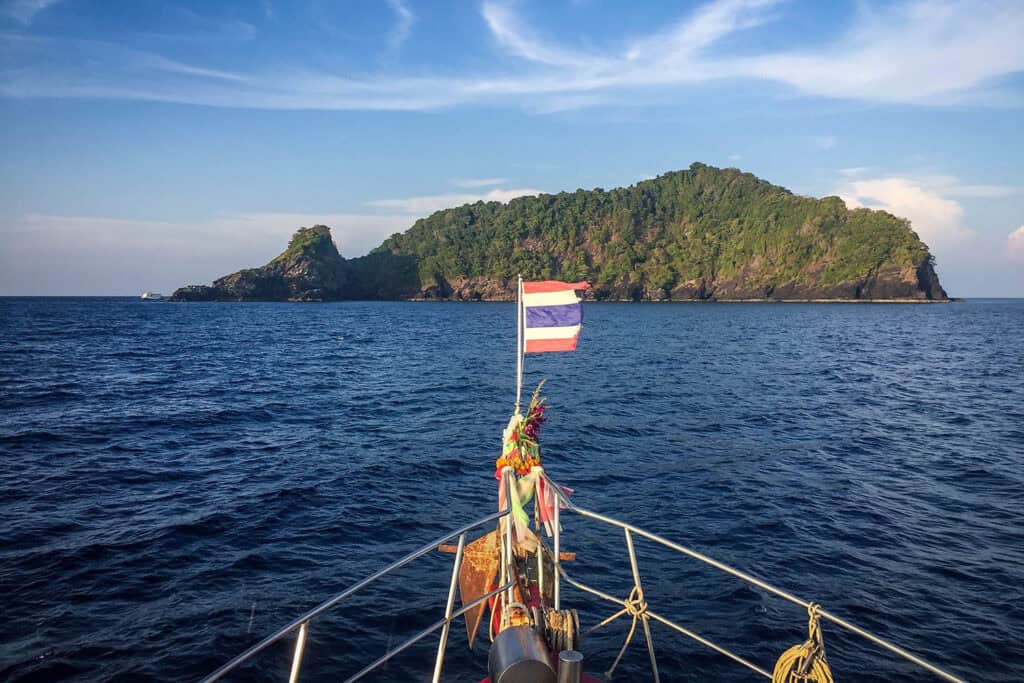
Are you ready to book a Liveaboard diving trip?! Whooo hoo! We don’t think you’ll regret it.
We have some excellent resources for booking your first Liveaboard diving experience.
- Best Scuba Diving Liveaboards Around the World (+ Expert Tips!)
- Best Thailand Liveaboards for Every Budget (+ Expert Tips!)
- Similan Islands Liveaboard: What to Expect + Top Recommendations
- Best Liveaboards in Indonesia for Every Budget (+ Expert Tips!)
- Komodo Liveaboard: What to Expect + Top Recommendations
- Best Liveaboards in Raja Ampat, Indonesia for Every Budget (+ Expert Tips!)
- Best Galapagos Liveaboards for Every Budget (+ Expert Tips!)
If you don’t see what you’re looking for, Liveaboard.com is also a fantastic resource to start your search. You can compare voyages, reviews, availability and prices all in one place, making it the easiest and most secure way to book your Liveaboard.
Questions to ask before booking your Liveaboard diving trip
Before you hit ‘book’ on your Liveaboard diving trip, be sure you understand what is included and what will cost extra. Here are some good questions to ask the company you’re going with:
Are there park fees?
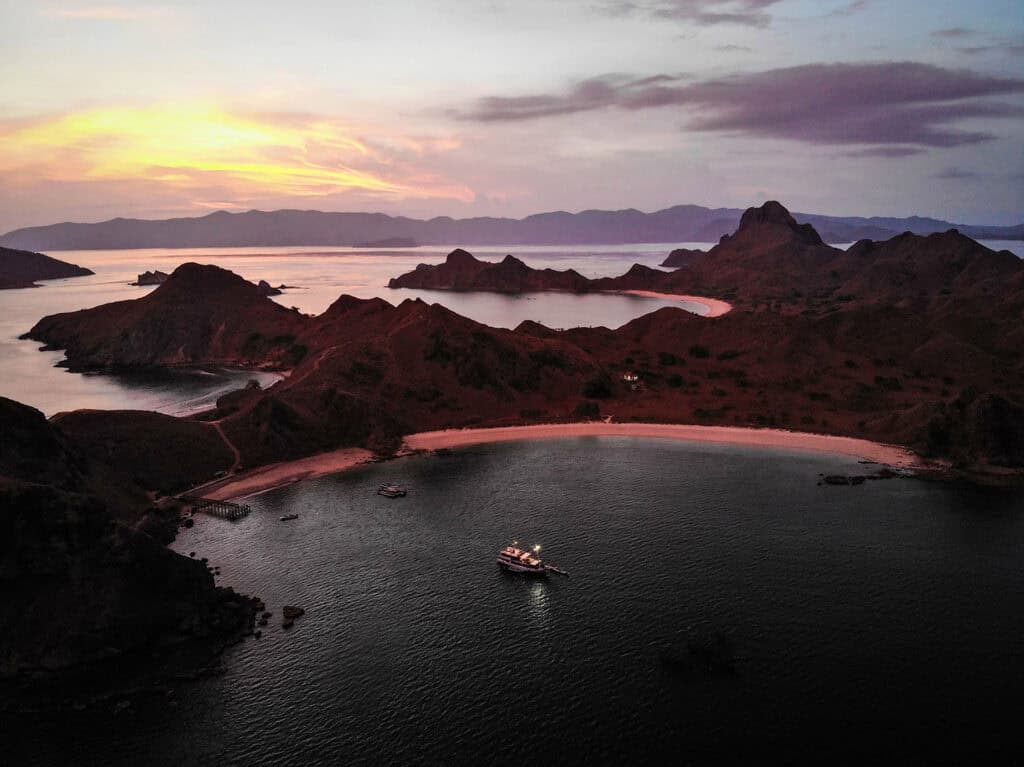
You’ll definitely want to know the answer to this question before you roll up to the dive shop. And if you’re traveling during high season, ask if the fee is more than usual.
On our Komodo Liveaboard, we were surprised that the park fees were quite a bit more expensive than we had been quoted at a different time of year. We are happy to support the conservation efforts, but just weren’t prepared (aka didn’t have enough cash on us!) to pay the 275,000 IDR fee per day (roughly $20 USD).
This worked out to be about $100 USD each for our 5-day trip.
Is rental gear included?
Unless you’re traveling with a wetsuit, mask and fins, it’s likely that you’ll need to rent at least a few pieces of gear. This is included in the price of some Liveaboards but is an additional cost for others. For example, we paid $10 USD each per day for our rental gear on our Komodo Liveaboard.
Are dive computers part of the rental gear package?
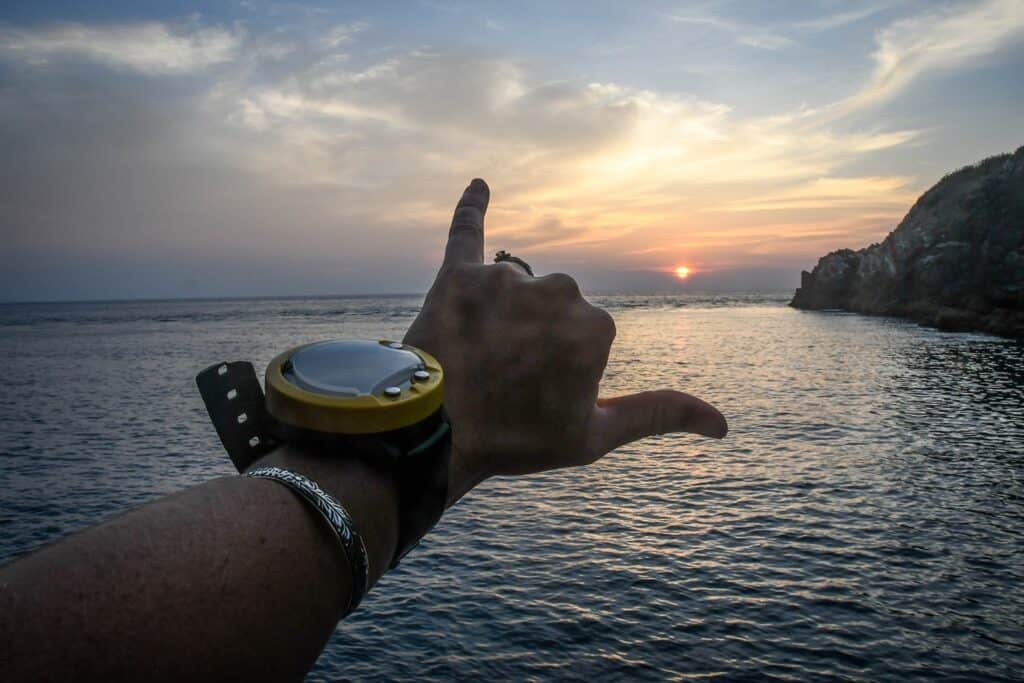
We learned how to dive in Thailand where it is common practice for all dive shops to give customers computers. We both feel much more comfortable with a dive computer, and honestly, it’s time we just make the investment and buy our own!
On our Similan Island Liveaboard, dive computers were part of the rental package, but in Komodo, they were $10 extra per day (150,000 IDR). Had we known ahead of time, we probably would have just bought our own computers before the trip.
Can you bring an underwater camera with you?
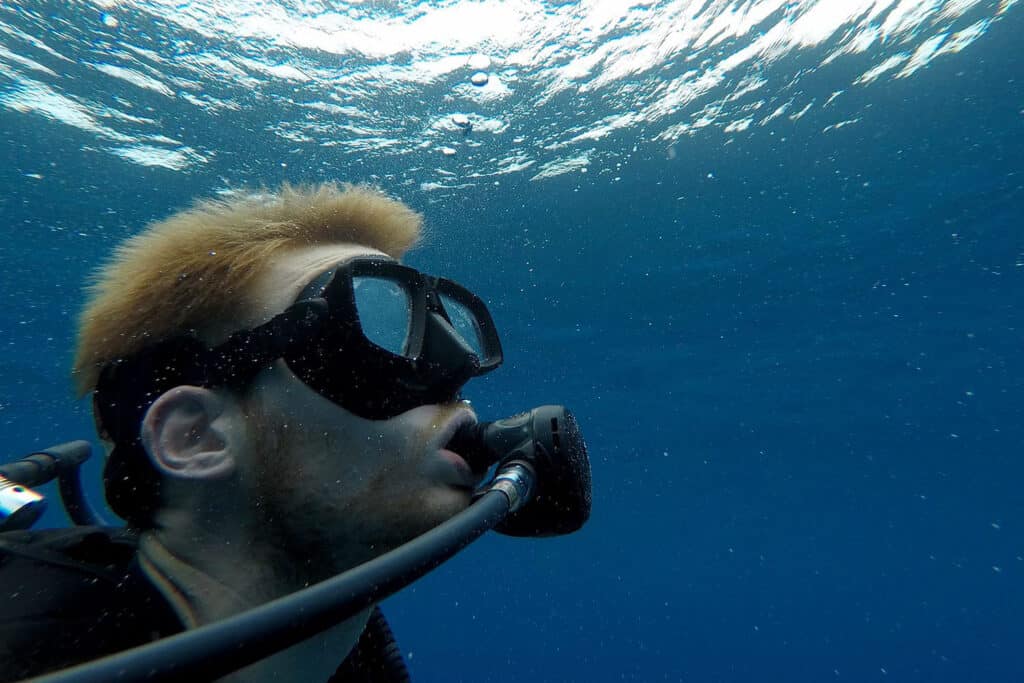
Some liveaboards have the opportunity to rent underwater camera equipment. Ask your liveaboard if they have camera rental options or bring your own. We’ve always just brought our GoPro, but some day we’d like to take a course in underwater photography and improve our photo skills!
If you have your own equipment, you’re usually not allowed to bring it on the first dive (unless you have underwater photography certifications), as instructors want to get a feel for your comfort level beneath the surface. They want to be sure you’re a confident diver before you have a camera in your hand to worry about.
Taking pictures underwater is very different from on land, so if you’re new to it read these tips on underwater photography.
Are there any opportunities to get off the boat during a Liveaboard?
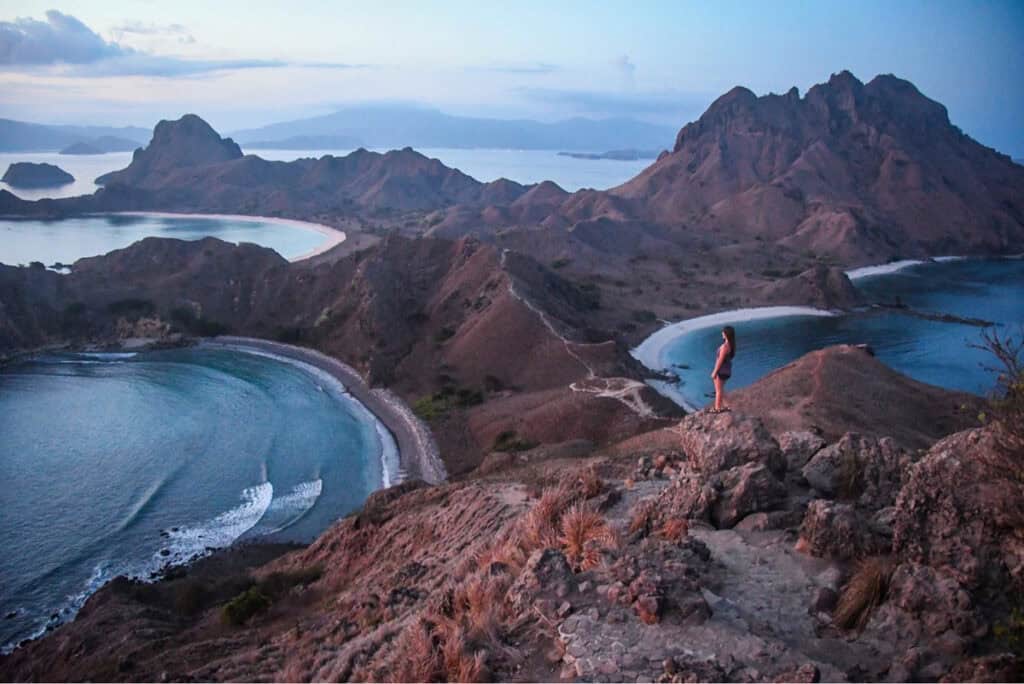
It totally depends on your itinerary! On our Similan Islands liveaboard, we were on the boat the whole time. However, our Liveaboard in Komodo National Park made a stop on one of the islands so we could see the famous Komodo dragons. We were happy to have some cash on us because this excursion was not included in the original fee.
Are alcoholic beverages extra?
Obviously, this is an optional cost, but if you feel like having a beer (or 2!) after the last dive of your day, you’ll want to know how much they charge for drinks onboard. And on some higher-end boats, drinks might even be included.
What is customary to tip on this Liveaboard?
The crew members on a Liveaboard boat work incredibly hard to cook your meals, keep your room clean, and make sure your equipment is properly set up.
Ask ahead of time how much is typical for guests to leave for gratuity so you can be prepared.
Liveaboard packing list
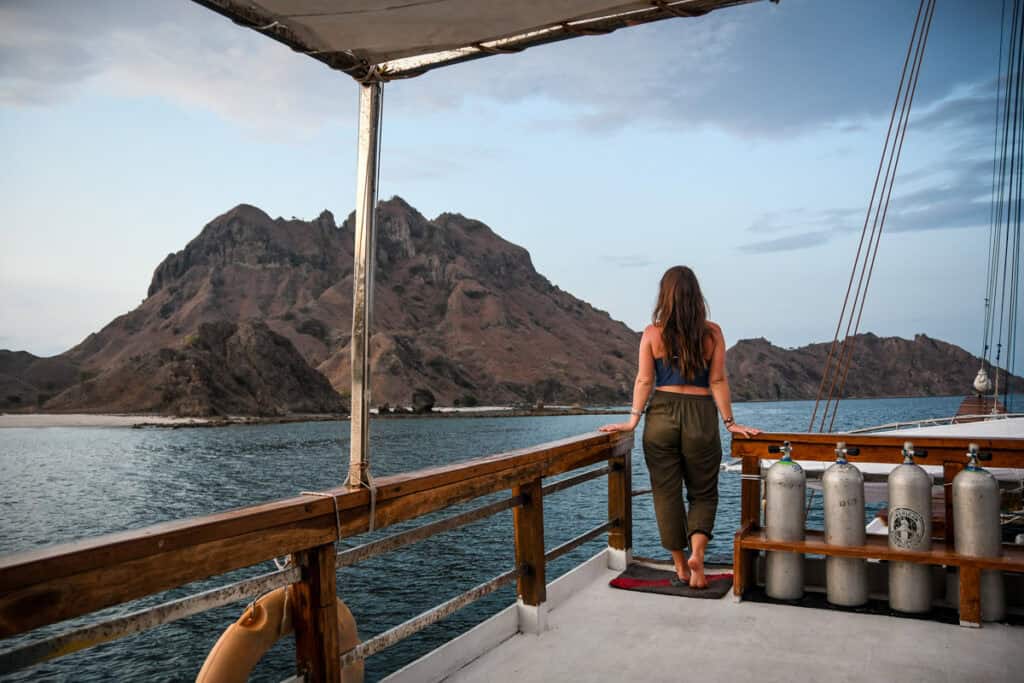
Now that you are all excited and ready to participate in your first Liveaboard diving experience, the only thing left to do is pack!
Figuring out what to pack for a Liveaboard diving trip can be tricky… you want to be prepared, but you definitely don’t want to overpack when you’re going to be living in tight quarters.
You truly really don’t need much on a Liveaboard, as you’ll basically be living in the same clothes during your whole trip. And your living quarters are likely smaller than what you’d expect on land, so our advice is to pack only what you need and leave the rest back at your hotel.
We’ve taken all the guesswork out of packing for you and compiled a complete Liveaboard packing list so you don’t forget any essentials on shore. Oh, and it’s totally FREE!

Don’t forget about travel insurance!
World Nomads provides coverage for adventure activities like scuba diving that aren’t usually covered (read the fine print!) in typical travel insurance policies. We recommend getting their short-term trip coverage (on top of your regular travel insurance plan) if you plan on doing a Liveaboard diving trip.
Get an instant quote on World Nomads right now, it’s that simple! It’ll take less than 3 minutes.
Eco-friendly Liveaboard tips
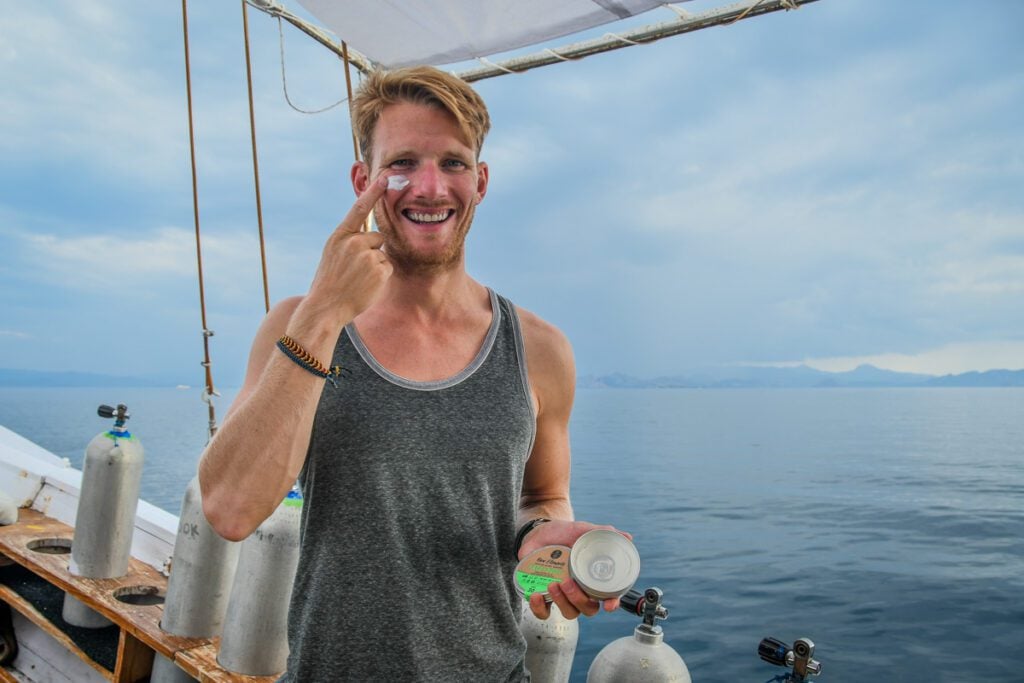
Whenever participating in a Liveaboard diving trip, it’s important to be mindful of the environment as you will be coming in contact with some of the world’s most fragile ecosystems.
1. Be mindful of the waste you create. If you have plastic bags or food wrappers, be sure to keep it in a safe place so they don’t fly overboard.
2. ONLY wear reef-safe sunscreen. Remember that any product you put on your body during your Liveaboard will end up in the ocean. This means it’s important that it is free of harsh chemicals that bleach the corals. Some Liveaboards have biodegradable soap and shampoo, which makes it easy.
3. Don’t touch anything underwater. This should be a no-brainer, but it’s worth repeating. Coral takes a long time to grow back after they’ve been broken, and marine creatures don’t need your fingers stuck in their faces. Practice good buoyancy, and be mindful of where your fins are at all times.
4. Choose an eco-friendly Liveaboard. When you’re deciding which Liveaboard to choose, do a little research on their environmental practices. Choose companies that support conservation, try to reduce their footprint and teach good diving practices.
Related Reading: Learn more about how to be a responsible traveler.
Are you interested in Liveaboard diving and want help planning your trip?
We have some great resources for you!
- Check out this list of the best scuba diving Liveaboards around the world.
- Read our personal account of our Similan Islands Liveaboard, our first ever Liveaboard dive trip!
- We gathered up all the best Thailand Liveaboards for every budget.
- Find out why our Komodo Liveaboard was the ultimate diving experience in Indonesia.
- Check out our roundup of the best Liveaboards in Indonesia, and if you already know what you’re looking for, here are the best Liveaboards in Raja Ampat.
- If you’re staying in the western hemisphere, these Galapagos Liveaboards are some of the best in the world!
Save this article on Pinterest for later!
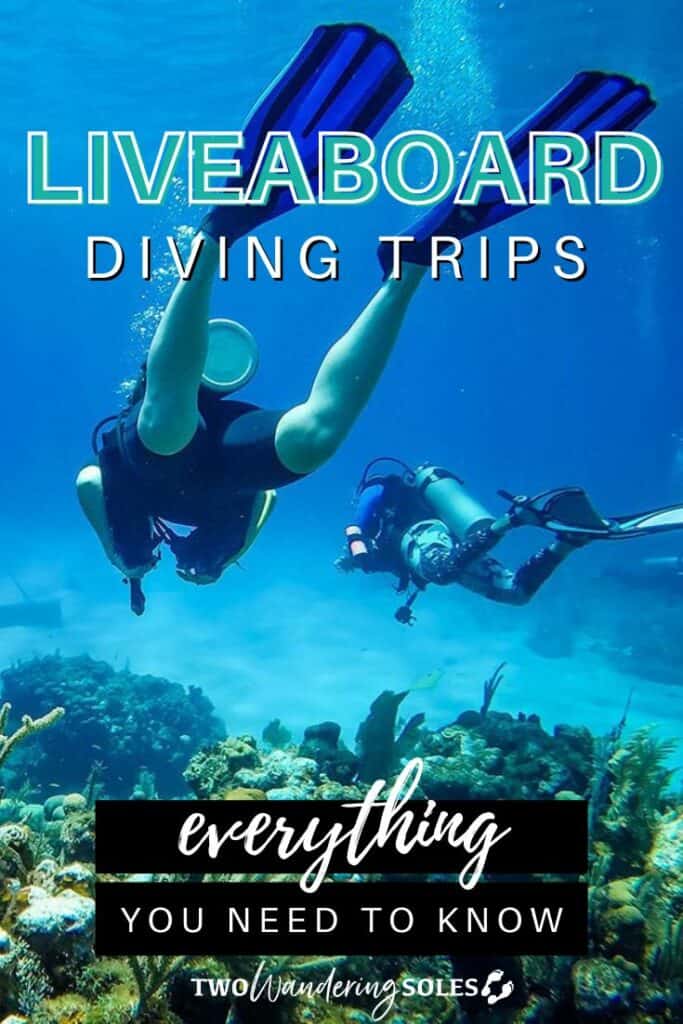
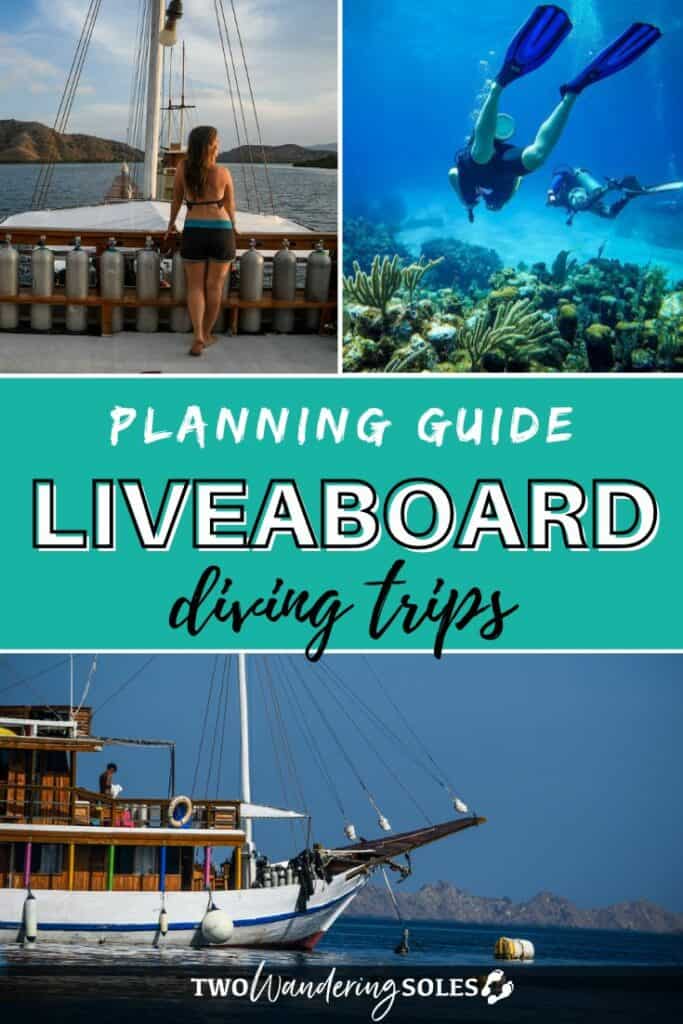
We want to hear from you!
Have you ever done a Liveaboard diving trip? What was your experience like? Do you have any advice you’d give to first-time Liveaboard-ers? Are you hooked on the idea of doing a Liveaboard dive trip of your own but still have questions? Comment below and we’ll do our best to get back to you!

Thanks for the article and info. I’ll be (hopefully) leaving for my first liveaboard next month. Excited!